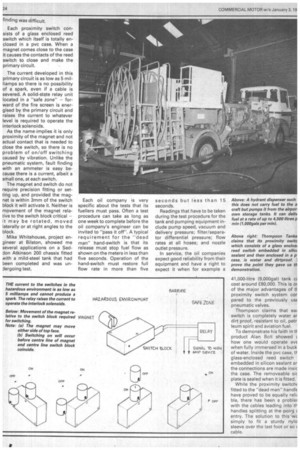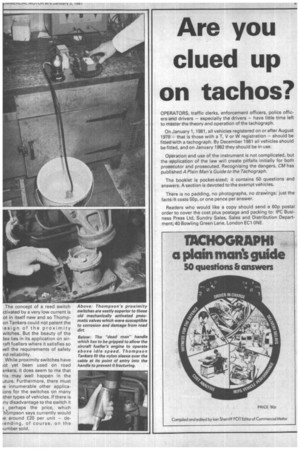Switch to safety in
Page 25

Page 26

Page 27

If you've noticed an error in this article please click here to report it so we can fix it.
aircraft refuellers MUNN
Tim Blakemore looks at a new development where speed and safety go together — one that could be adopted in other sectors of the transport industry
1ELAY when loading and un)ading is afamiliar haulage roblem. Consider how much reater this is for airlines with quipment — aircraft — costing everal hundred times more -Ian the most expensive lorry nd instead of drivers pilots on luch higher pay than the highst paid lorry driver will ever ee.
Vehicles used to service airraft are highly specialised artly because they have to proide such a fast service to enable ircraft to be turned around uickly. But for aircraft fuellers 1 particular, safety is even more nportant than speed.
Aviation fuel is a volatile liquid though with a flash point higher than that of petrol) and a fully fuelled Boeing 747 has two million litres (44,000 gallons) of it. Safety and speed do not usually go together and close liaison between the oil companies which operate the fuellers and the tanker manufacturers is needed to ensure that the equipment satisfies both requirements.
Thompson Tankers, an operating division of NEI Clarke Chap
man Engineering Ltd (NEI stands for Northern Engineering Industries) claims 80 per cent of the aircraft fuellers' market.
I visited the company's main plant at Bilston in the Midlands to see aircraft fuellers being constructed and tested but specifically to learn about Thompson's proximity switch, which can't cause a spark and has been used on fuellers by petroleum cornpanies for the past three years.
The switches were originally developed by Wilf Pearce, technical manager, and Alan Bolt, foreman auto-electrician at Bilston, to activate the interlocks that are fitted to aircraft fuellers. Today they are also used for these vehicles' "dead-man" handles and Thompson Tanker believe that there must be man more applications for the idea.
Each petroleum company ha its own particular specificatio but a typical interlock system i linked to the vehicle's brakin system and prevents the brakE from being released unless a fuelling nozzles and hoses ar stowed correctly, all door closed and fuelling booms full retracted.
This prevents the vehicle fror being moved during loading, o loading and fuelling operation. It would obviously be an exper sive and dangerous mistake if fueller were to move off whili unknown to the driver, a hoE was still connected to a mull 'million pound aircraft.
The "dead-man" handle a switch on a retractable lea that allows the operator to reac all the fueller's controls whi still gripping it. If it is releasE the engine will be preventE from running above idle speel So it is impossible for th operator to walk away from tlfueller and leave it pumping fuE That is important when the flo rate of the fuel can be as muc as 4500 litres per min (1,000g per min).
Before the proximity switch( were developed, pneumat valves were used to activate th interlocks, but the mechanic actuators were prone to failur often caused by road dirt or co rosion. Furthermore, on a typic fairly complex system wit perhaps six interlocks, fau finding was difficult.
Each proximity switch consists of a glass enclosed reed switch which itself is totally enclosed in a pvc case. When a magnet comes close to the case it causes the contacts of the reed switch to close and make the primary circuit.
The current developed in this primary circuit is as low as 5 mil liamps so there is no possibility of a spark, even if a cable is severed. A solid-state relay unit located in a "safe zone" — for ward of the fire screen is energised by the primary circuit and raises the current to whatever level is required to operate the interlock solenoids.
As the name implies it is only proximity of the magnet and not actual contact that is needed to close the switch, so there is no problem of on/off switching caused by vibration. Unlike the pneumatic system, fault finding with an ammeter is easy because there is a current, albeit a small one, at each switch.
The magnet and switch do not require precision fitting or set ting up, and provided the magnet is within 3mm of the switch block it will activate it. Neither is movement of the magnet relative to the switch block critical — it may be rotated, moved laterally or at right angles to the block.
Mike Whitehouse, project engineer at Bilston, showed me several applications on a Seddon Atkinson 200 chassis fitted with a mild-steel tank that had been completed and was undergoing test. Each oil company is very specific about the tests that its fuellers must pass. Often a test procedure can take as long as one week to complete before the oil company's engineer can be invited to "pass it off". A typical requirement for the "dead man" hand-switch is that its release must stop fuel flow as shown on the meters in less than five seconds. Operation of the hand-switch must restore full flow rate in more than five seconds but less than 15 seconds.
Readings that have to be taken during the test procedure for the tank and pumping equipment include pump speed, vacuum and delivery pressure; filter/separator differential pressure; flow rates at all hoses; and nozzle outlet pressure.
In service, the oil companies expect good reliability from their equipment and have a right to expect it when for example a
41,000-litre (9,000gall tank c( cost around £80,000. This is or of the major advantages of tt proximity switch system cor pared to the previously USE pneumatic valves.
Thompson claims that ea( switch is completely water ar dirt proof, resistant to oil, petr leum spirit and aviation fuel.
To demonstrate his faith in th product Alan Bolt showed t how one would operate evE when fully immersed in a buck of water. Inside the pvc case, th glass-enclosed reed switch embedded in silicon sealant ar the connections are made insic the case. The removeable sic plate is sealed when it is fitted.
While the proximity switch( fitted to the "dead man" handlE have proved to be equally relii ble, there has been a probler with the cables leading into th handles splitting at the point. ( entry. The solution to this `vve simply to fit a sturdy nylo sleeve over the last foot or so ( cable. The concept of a reed switch ctivated by a very low current is ot in itself new and so Thompon Tankers could not patent the esign of the proximity witches. But the beauty of the Jea lies in its application on airraft fuellers where it satisfies so dell the requirements of safety nd reliability.
While proximity switches have lot yet been used on road ankers, it does seem to me that his may well happen in the uture. Furthermore, there must le innumerable other applicaions for the switches on many ither types of vehicles. If there is ny disadvantage to the switch it
perhaps the price, wh;ch -11C,mpson says currently would ie around £20 per unit — deending, of course, on the lumber sold.












































































